You are using an out of date browser. It may not display this or other websites correctly.
You should upgrade or use an alternative browser.
You should upgrade or use an alternative browser.
Luxury & Precision P6 Pro Advanced Discrete R-2R Portable Audio Player
- Added by o0genesis0o
- Create date
grumpy213
100+ Head-Fier
Pros: Wonderfully analogue and smooth sound
Superb technical ability despite sound signature
Excellent form factor
Superb technical ability despite sound signature
Excellent form factor
Cons: Treble response could be more engaging
Poor software experience
Not the most detailed source for the price
Expensive
Poor software experience
Not the most detailed source for the price
Expensive
Luxury & Precision (LP) P6 Pro (P6P)

Preamble
Digital audio players (DAPs) harken back to the past of dumbphones and the need to carry around a dedicated device for music playback. From the Walkman to the iPod and now to the modern day DAP, these audio players are far less ubiquitous amongst the general population now and are more specialised devices for the discerning audiophile. But the variety that exists within the ranks of DAPs is something to behold, there are devices that harken back to the iPod Shuffle with tiny screens, devices that resemble bricks and are able to match some desktop devices for raw power output and perhaps, most unique of them all, are the offerings from LP.Today’s review concerns the LP P6P, a device that is rather old in the fast-moving realm of DAPs but presents a unique proposition in that it utilises an R2R DAC, doesn’t run Android and costs an eyewatering $3,900 USD. But what does the extra money in what is essentially an iPod get you?
Many thanks to @Damz87 and the Australian Head-Fi Tour for this review unit.
The Factual Stuff
Fashioned out of aluminium, the design of the P6 Pro takes some flourishes with the extruded side that acts as a guard for the gold rotary knob. The aluminium is then broken up with a wonderful wood grain back. The buttons are nicely tactile and you receive the playback buttons on the left side, some navigation buttons on the right side and the power button to the top. Sitting alongside the power button are the two outputs, 3.5mm and 4.4mm with both supporting power out and line out should you wish to connect the P6P to an external amp. The bottom of the P6P also has a USB-C port and a SD card slot.Within the P6P is an resistor-to-resistor digital to analogue converter (R2R DAC) that consists of various resistors cherry-picked from the P6 parts bin to create what LP calls “the equivalent to using 16 PCM 1704K R-2R chips in parallel”…whatever that means.
The Opinion Stuff
Sound
The following impressions are with the P6P on the latest firmware (1.0.1.4), high gain, fast attenuation filter (with some additional notes on NOS) and connected to one of the following IEMs:- Unique Melody MEST MK 2
- Unique Melody Multiverse Mentor;
- Campfire Audio Supermoon; and
- Elysian Annihilator.
Bass
The low-end of the P6P is unlike some of the DAPs that have crossed my table over the last year or so. Whereas many seem to take the approach of lifting this region in order to present a more bombastic and engaging sound signature, to which I have no issue with, the P6P doesn’t really do much in terms of quantity. IEMs seem to sound similar or less bassy to other sources on hand when used with the P6P but where it really shines is in its quality.The P6P imbues a natural and analogue quantity to the low-end whilst retaining control. There is a visceral feeling of air vibrating not unlike a bass drum reverberating and kicking up dust in the process. But this also remains tight and controlled, not descending into a boomy mess. There is a natural sense of decay imbued by the P6P which is most evident in the very fast, planar magnetic Supermoon. There is an enjoyment in the sheer speed of the Supermoon, but the P6P seems to relax it, take the edge off and imbue a nicely smooth rendition of it that is really enjoyable to listen to.
Low-end notes have a great sense of texture and detail that allows the end-user to listen critically to notes but not at the cost of the pace and rhythm of their music. Unlike the usual ‘analogue, natural’ source chains that I have tried (Cayin RU7, RU6 and some tube amps), there is a retention of dynamism and timing. It is not slow nor is it super fast, it strikes a balance between the two and the result is, in my opinion, wholly enjoyable.
This is not the be all, end all for super fast EDM nor metal but the balance struck in the P6P is an excellent listening experience once you are used to it.
Mids
Listening to mid-range focused music on the P6P is an absolute treat. Vocalists feel naturally timbred and analogue in their singing with a very slight honeyed quality to it. I say that in that there is all smooth and rounded edges here that do not seek to overwhelm you with detail and (sometimes) corresponding edginess that comes with it. There is a distinct lack of emotional engagement with certain soruces in the market with many seemingly placing a sharpening filter over the top of mids in order to draw out heightened detail and perceived ‘resolution. The P6P presents in a smoother, more relaxed and euphonic experience. It is very easy to get lost in a playlist of strong vocal performances and certain songs caused goosebumps.This is not to say that the P6P is for the deafer half of audiophiles as it still retains a strong sense of detail and resolution that will be more touched upon in the Technicalities section below.
Instrumentalisation is also similarly excellent. There is a caveat in the smoothness of the P6P in that harder edged plucking of a guitar seems to lose that strong edginess that one would come to expect but otherwise, it all feels visceral, emotive and easy to listen to.
These insights were most apparent on the Elysian Annihilator and the Supermoon, both taking a more lifted upper-mid region that seems to eek out a sense of sibilance on certain sources. The P6P seemed to tame this region and generate a less fatiguing and still very enjoyable experience.
Treble
The upper-regions of the FR curve is hardly the most standout element to me and I am far from a treble head. With that being said, I do not believe that the treble region of the P6P provides any standout aspect. If anything, the P6P seems to reduce the level of energy in this region providing me with a more ‘laid-back’ rendition of spicy hi-hats and piercing synths. There is basically no sense of sibilance or fatigue generated by the P6P when listening for long periods of time but for whatever reason, there is a want for this. It is natural to expect that a belting singer or a sizzling synth or a crash of a cymbal cause a minutia of wincing that leads you to feel the hairs on the back of your neck to stand up. In this regard, the frequency that the P6P provided this was few and far between.It doesn’t devolve into something I would describe as ‘dark’ but the lack of energy in this region leaves a little more to be desired. I cannot commit to describing any aspect of this region as being crystalline and crisp nor can I say it is sparkly and hugely engaging in the context of its tonal balance. The treble feels safe, which is not a wrong thing by any means but may be disappointing to some.
The previously mentioned Anni and the Supermoon both have unique treble responses, the former being overall just excellent in balancing a sparkly and forward treble region and the latter being very speedy and somewhat edgy. The P6P doesn’t muddle these IEMs into being dark and veiled but rather present them in a new manner that is both enjoyable and manageable from a fatigue standpoint.
Overall, the treble region of the P6P is the audio equivalent of wanting medium salsa and getting mild. Nothing wrong with it but I just wanted a little bit more pain oddly enough.
Technicalities
The P6P’s technical performance is excellent despite its tonality. This is not a DAP that renders hyper detail and throws it at you non-stop, but rather is more laidback and smoother in its rendition. The P6P seems to meander out the notes and leaves it up to you to discern. Like the cute girl who just showed up to the house party without an invite, you weren’t expecting detail but you’re happy to see them regardless. Listening sessions with the P6P are very easy and there is nothing that commands your attention and so there may be a tendency to not believe the P6P to be great in terms of resolution. But listen closer and you can pick out notes, certain regions of the FR curve and image them precisely in a rather large stage.The P6P retains coherency and resolution concurrently as I feel that a more ‘hyperdetailed’ DAP may seem a little too incoherent and jarring form time-to-time. Microdetails are there for you to notice at your leisure instead of jamming a minor mistake by the sound engineer into your earholes.
Staging is wiiiide and deeeeep. The extra letters are for emphasis and for good reason, the combination of its natural and smooth tonality combined with this great staging provides for an excellent experience of being enveloped in your music. I believe that the experience is a truly holographic stage experience that doesn’t push it to the point of being overly-diffuse and unengaging.
The noise floor seems excellent and whilst I no longer have super sensitive IEMs, the P6P, even when amplified by an external amp, provides me with very little hissing.
Overall, the technical performance of the P6P are not elements that jump out at you but rather slowly win you over and then you realise when switching to a traditional DAP that you were hearing everything all along, just in a more natural and smooth manner.

Variables
The P6P comes with a number of digital filters for you to use at your leisure. Whilst these differences are subtle, I feel that they are as follows:- NOS – non-oversampling on an R2R DAC is just dipping your music in honey and applying a beauty filter on it. This is the smoothest and most easy to listen to filter and it is the default for good reason. Natural and effortless in its rendition, it is only let down by a reduced sense of detailing.
- Fast attenuation – This sharpens up your listening experience and details start to present themselves in a much more aggressive manner. Leading edges of notes are clearly defined and microdetails become far more easier to discern in the mix. The downfall of this is that certain songs become more fatiguing and less easy to listen to.
- Slow attenuation – In between fast and slow in my opinion, there is a level of smoothness and ease of rendition but the details of the music are still presenting themselves in a manner that are dissectible. Oddly enough, I do not love this filter as I feel that things get a little lethargic without being hugely enjoyable.
Comparisons
Shanling M6 Ultra (M6U)
This is hardly a competitor in terms of price, but this is the only DAP I have on hand worth comparing. The M6U presents music in a similarly smooth manner but also with a heightening of warmth and a slight uplift in the treble region. This DAP seeks to be an engaging one and it does so with some slight issues. The warmth of the M6U presents itself as slightly boomy with certain IEMs whereas the P6P remains distinctly linear despite its smooth rendition. Technical performance on the P6P far outstrips the M6U in terms of stage, resolution and dynamics. The M6U is a decent DAP and has been my daily driver for a long period of time but counts only UI / UX as benefits over the P6P and sound quality, except for a subjective affinity for any particular tuning that the M6U has, is a significant gap.Mojo 2
The Mojo 2 is a very compact DAC / Amp that provides you with a slight warm tilt tuning and a technical performance that rivals devices in higher price brackets.The addition of DSP features in the Mojo 2 do provide a distinct advantage for the end-user but for the purposes of this review, I will not be addressing this.
Tonally, the Mojo takes a slightly warmer approach to neutral that is quite enjoyable to listen to but unlike the P6P, it retains an edge to its notes that is readily discernible.
The technical performance of the Mojo 2 is quite excellent but unlike the P6P it opts for a more in your face rendition of detail that is less cohesive. The sound is less smooth than the P6P and there is a greater ‘edge’ to the notes being produced. The Mojo 2 also has a higher noise floor than the P6P and still manages to trump the P6P from a usability standpoint despite its Chord quirks.
Sonically, the Mojo2 presents a well rounded and capable device for detail rendering and DSP capabilities. Where the P6P trumps it is in its ability to render detail whilst providing an extremely cohesive and smooth sound signature.
Value & Quality of Life
Time to come to the elephant in the room. As much as I enjoyed this DAP and listened to it for hours on end, there is a distinct and perhaps, fatal flaw in it. It is an absolutely nightmarish user experience. Opting out of Android was likely done to minimise interference from the components required to run the operating system and they have opted for a lower-powered CPU and their own OS. The result is a user interface from an MP3 player from any other company than Apple in 2003 and a corresponding level of responsiveness. There are a laundry list of issues and a learning curve that is quite difficult to overcome yourself. First, the SD card you’re using must be FAT32, which is ancient at this point. Second, you should name your library in a manner that suits LP, this includes a numbering convention and maybe remove some symbols to allow it actually complete indexing your SD card. Thirdly and finally, I hope you like shuffle, no gapless playback and just having a bad time scrolling around.These issues are frustrating to say the least and not at all intuitive. But therein lies the rub. I spent a few hours renaming folders, files and reformatting SD cards and running scripts found on Head-Fi to get this thing to work. That’s just how good it sounds! But I didn’t pay for this, and if I did without doing any research, I would say that I would be extremely annoyed and likely requesting a refund. The P6P is not for the faint of heart, and definitely not for the price. However, if sound quality is all you are after and you have no reservations about these creature comforts, then this is simply the best DAP and perhaps portable source I have listened to.
Outside of these UX concerns, the P6P is considerably smaller and lighter than other flagships in the market that resemble bricks and are on the very borderline of portable. There are some nice features such as Bluetooth connectivity and ability to be used as a USB DAC/AMP which alleviates some of the issues of directly interacting with the UI. The line-out is also variable and allows for fine tuning volume output to external amps for great usability. This is a killer feature for amps such as the Sound Tiger Sinfonia with a fixed output. The P6P manages to pack all this sound quality into a rather pocketable package that is easy to manipulate and that is an achievement in of itself.
Conclusion
The road to audio nirvana is paved with good intentions that turn out to be horrendous in practical use. Slow, headache-inducing quirks and a distinct lack of features, the P6P when viewed and experienced without IEMs in is an absolutely terrible option for a DAP. But the key point here is that it is a DAP, it’s raison d’etre is to produce music and boy does it produce music. Smooth yet detailed, spacious yet engaging, tight yet relaxed, the P6P envelops you in a warm-hug of music that is easy to enjoy, get lost in and simply forget about the 4.5 hours you spent getting it to work.For that I commend LP and pray that they hire some more people for their OS development.

Last edited:
Damz87
Excellent review as always @grumpy213 !
lycos
100+ Head-Fier
Pros: -Huge soundstage
-Very good details (with Fast Attenuation filter)
-Laidback R2R sound
-Small and light
-Very good details (with Fast Attenuation filter)
-Laidback R2R sound
-Small and light
Cons: -Treble is too recessed
-Lack of energy
-Over-smooth
-Price over performance ratio
-Lack of energy
-Over-smooth
-Price over performance ratio
Luxury & Precision P6 Pro
Luxury & Precision P6 Pro is a $3899 R2R DAP, purely designed for music (ie no Android, no wifi).

I love the classy timeless aesthetic of P6 Pro with wood back panel and engraved with the brand name. At 230gr, its definitely the lightest among TOTL daps.

The User Interface (UI) is simple and plain without capability for customisation. There are few quirks that I found with the DAP:
-USB setting automatically reset to MSC (storage) everytime unit is turned on - even if previously USB DAC was selected. I often connect P6 Pro to my laptop - so I can listen to Qobuz streaming. I would need to change the setting everytime. No big deal just small nuisance.
-Volume cannot be adjusted if no music is playing. I have a habit to dial down the volume before start playing to avoid blasting my eardrum since I have multiple iems with different sensitivity. This unfortunately isn’t possible with P6 Pro.
-SD card needs to be in old FAT32 format. That means my sd card that has already 300GB musics would need to be reformatted first.
-Screen isn’t that bright even at max setting. This makes it more difficult to see during the day

Next is the sound impression. It is done on default filter setting: NOS.
P6 Pro is a neutral-warm-ish dap. The bass has just enough punch and well controlled. The vocal sounds natural, relaxed with hint of warmth.
Treble for me is too recessed. It lacks of sparkle and energy.

The soundstage is huge - its what I enjoy the most in LP6 Pro.
Attacking edge unfortunately is just too blunt/ over-smooth. The dynamics is just too sluggish.
There is lack of notes richness in P6 Pro. It struggles to reproduce complex layering in music - everything seems to mashed together.
I tried different filter setting: Fast attenuation. It sounds snappier which improves dynamics, instrument separation slightly improves at the expense of less wide soundstage.
Comparison with Shanling M9+

P6 Pro is more neutral while M9+ is V shape with emphasis on subbass.
P6 Pro has more spacious soundstage while M9+ is more intimate.
In term of imaging, P6 Pro is less precise and hazier.
P6 Pro esp in Fast attenuation filter has very good detail retrieval. However, it is still outclassed by the newer M9+
To sum up, P6 Pro is not a dap for me. My main complain is the sound is too smooth and lack of energy. However, I can see this dap would be perfect for those who want offline music player with laidback sound and very good details.
Big thanks to L&P and @Damz87 for organising this tour.

Luxury & Precision P6 Pro is a $3899 R2R DAP, purely designed for music (ie no Android, no wifi).

I love the classy timeless aesthetic of P6 Pro with wood back panel and engraved with the brand name. At 230gr, its definitely the lightest among TOTL daps.

The User Interface (UI) is simple and plain without capability for customisation. There are few quirks that I found with the DAP:
-USB setting automatically reset to MSC (storage) everytime unit is turned on - even if previously USB DAC was selected. I often connect P6 Pro to my laptop - so I can listen to Qobuz streaming. I would need to change the setting everytime. No big deal just small nuisance.
-Volume cannot be adjusted if no music is playing. I have a habit to dial down the volume before start playing to avoid blasting my eardrum since I have multiple iems with different sensitivity. This unfortunately isn’t possible with P6 Pro.
-SD card needs to be in old FAT32 format. That means my sd card that has already 300GB musics would need to be reformatted first.
-Screen isn’t that bright even at max setting. This makes it more difficult to see during the day

Next is the sound impression. It is done on default filter setting: NOS.
P6 Pro is a neutral-warm-ish dap. The bass has just enough punch and well controlled. The vocal sounds natural, relaxed with hint of warmth.
Treble for me is too recessed. It lacks of sparkle and energy.

The soundstage is huge - its what I enjoy the most in LP6 Pro.
Attacking edge unfortunately is just too blunt/ over-smooth. The dynamics is just too sluggish.
There is lack of notes richness in P6 Pro. It struggles to reproduce complex layering in music - everything seems to mashed together.
I tried different filter setting: Fast attenuation. It sounds snappier which improves dynamics, instrument separation slightly improves at the expense of less wide soundstage.
Comparison with Shanling M9+

P6 Pro is more neutral while M9+ is V shape with emphasis on subbass.
P6 Pro has more spacious soundstage while M9+ is more intimate.
In term of imaging, P6 Pro is less precise and hazier.
P6 Pro esp in Fast attenuation filter has very good detail retrieval. However, it is still outclassed by the newer M9+
To sum up, P6 Pro is not a dap for me. My main complain is the sound is too smooth and lack of energy. However, I can see this dap would be perfect for those who want offline music player with laidback sound and very good details.
Big thanks to L&P and @Damz87 for organising this tour.

o0genesis0o
Headphoneus Supremus
Pros: + Excellent design, build quality, and finishing
+ Outstanding sound quality
+ Outstanding sound quality
Cons: - No gapless playback
- Price
- Price
Ever since I fell down the personal audio rabbit hole, I have always been fascinated by a curious phenomenon: the enduring appeal of high-end (read: very expensive) digital audio players (DAP) amongst hardcore IEM fans. Today, we look at Luxury & Precision P6 Pro, a $3899 digital audio player (DAP), from the perspective of a sceptical IEM geek to understand this strange fascination.
If you want to listen instead of reading, please find the video review on YouTube below. Otherwise, read on, friends.
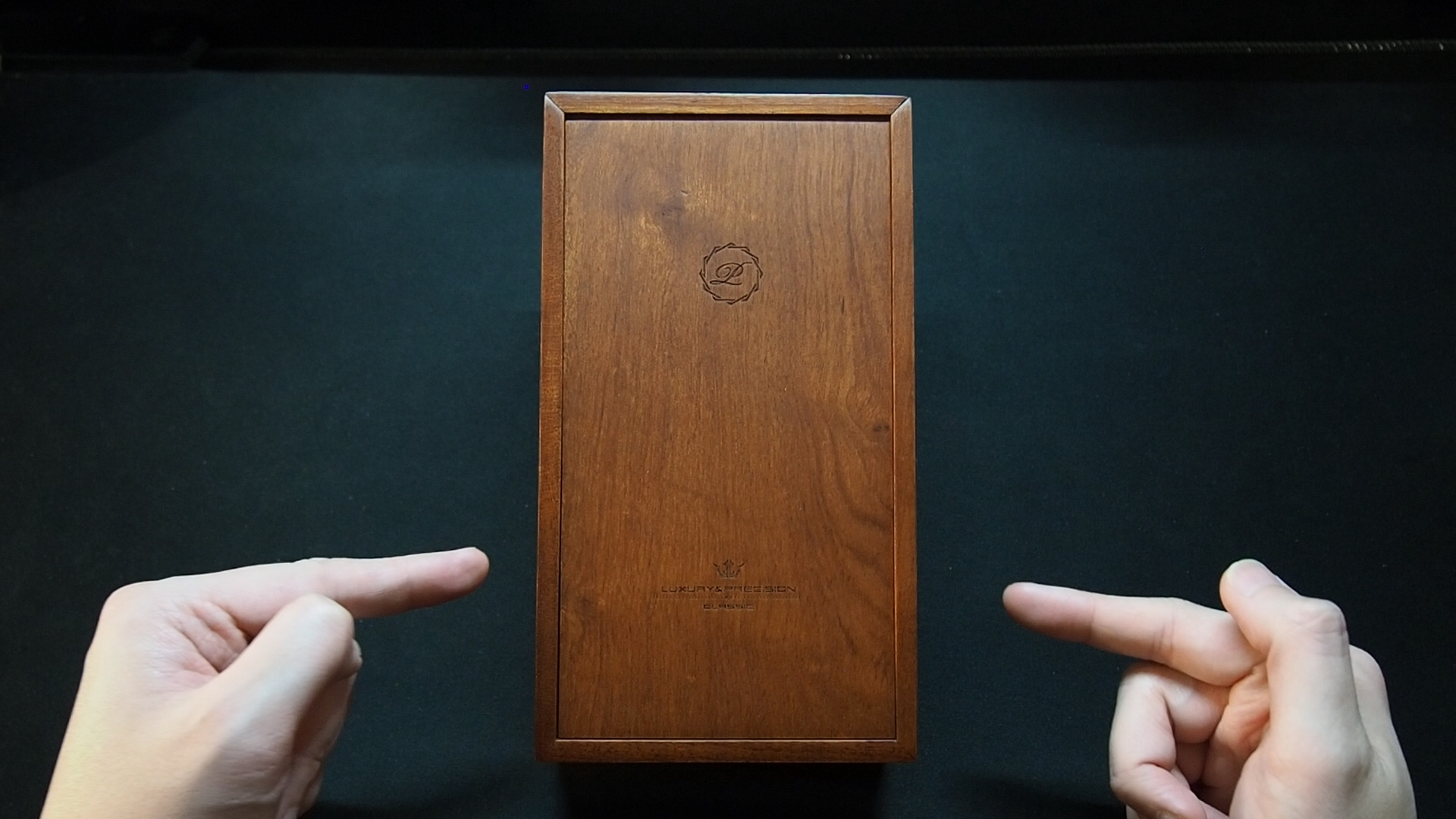
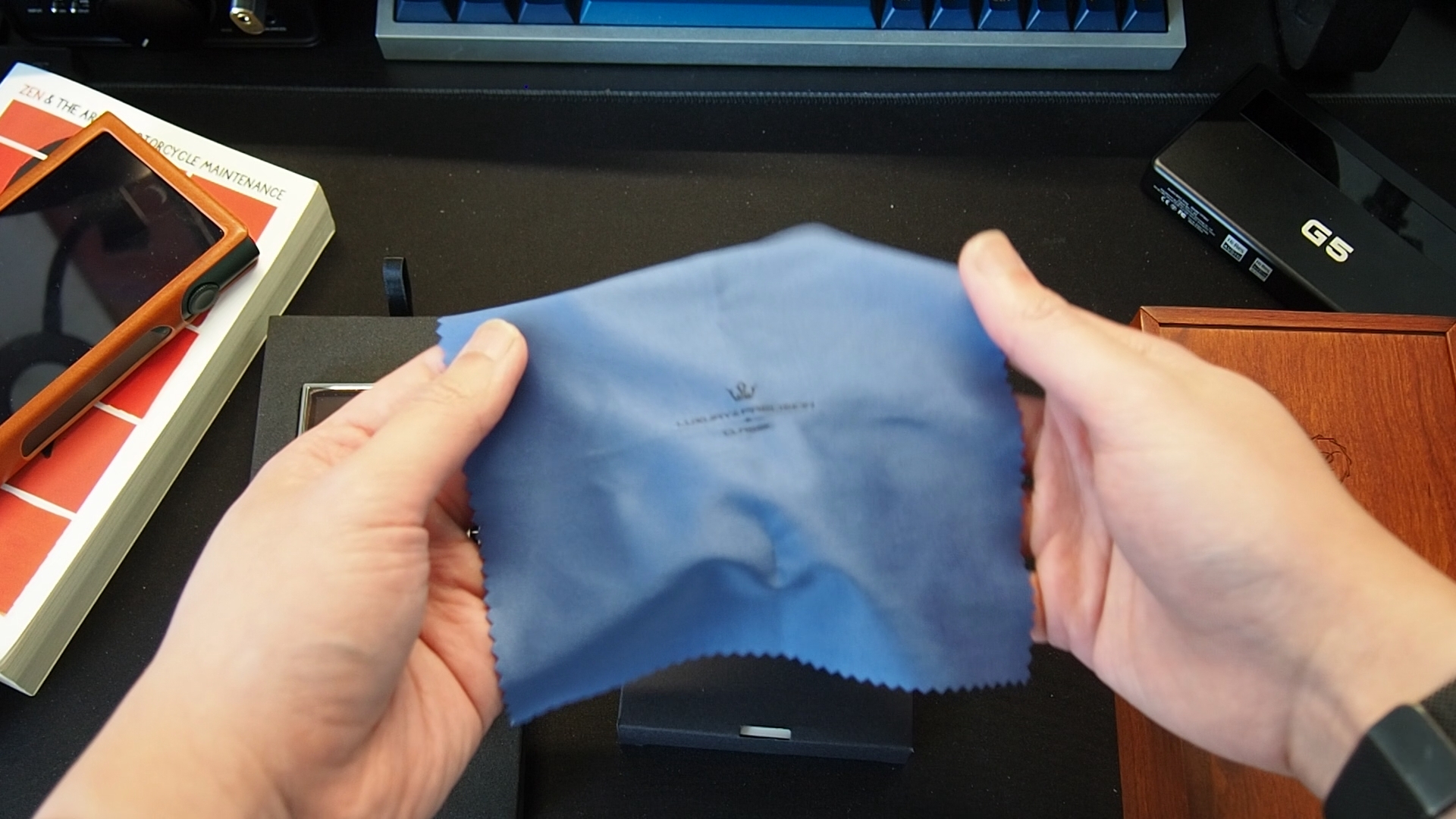
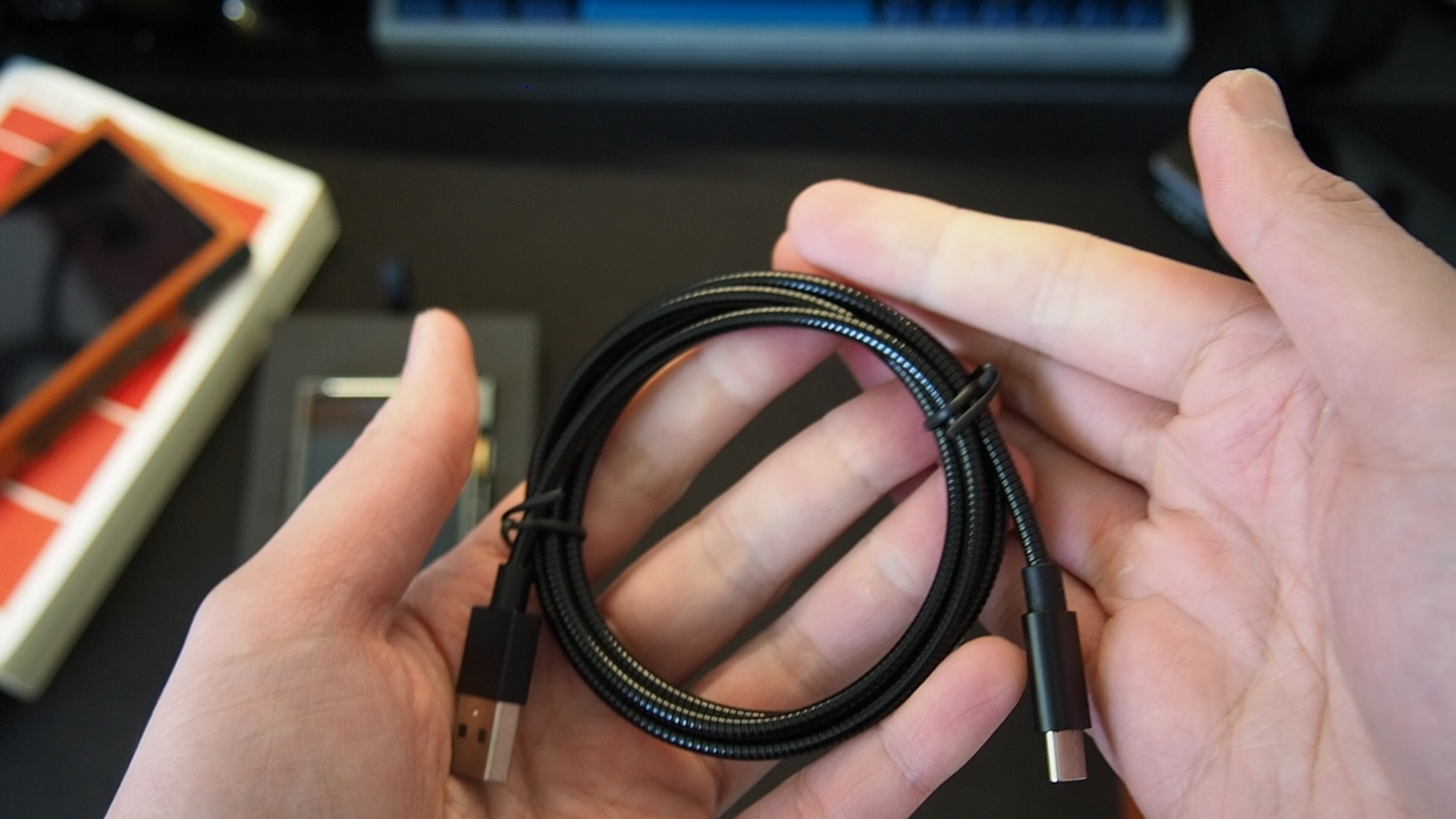
My first impression when unboxing the unit was luxury (and precision). The DAP comes in a heavy wooden box that feels great to the touch, looks luxurious and, thanks to the magnets, closes precisely with a satisfying snap. After removing a protective foam panel, you will find the luxurious DAP sitting on a layer of precisely cut foam. (Alright, alright, I’ll stop).

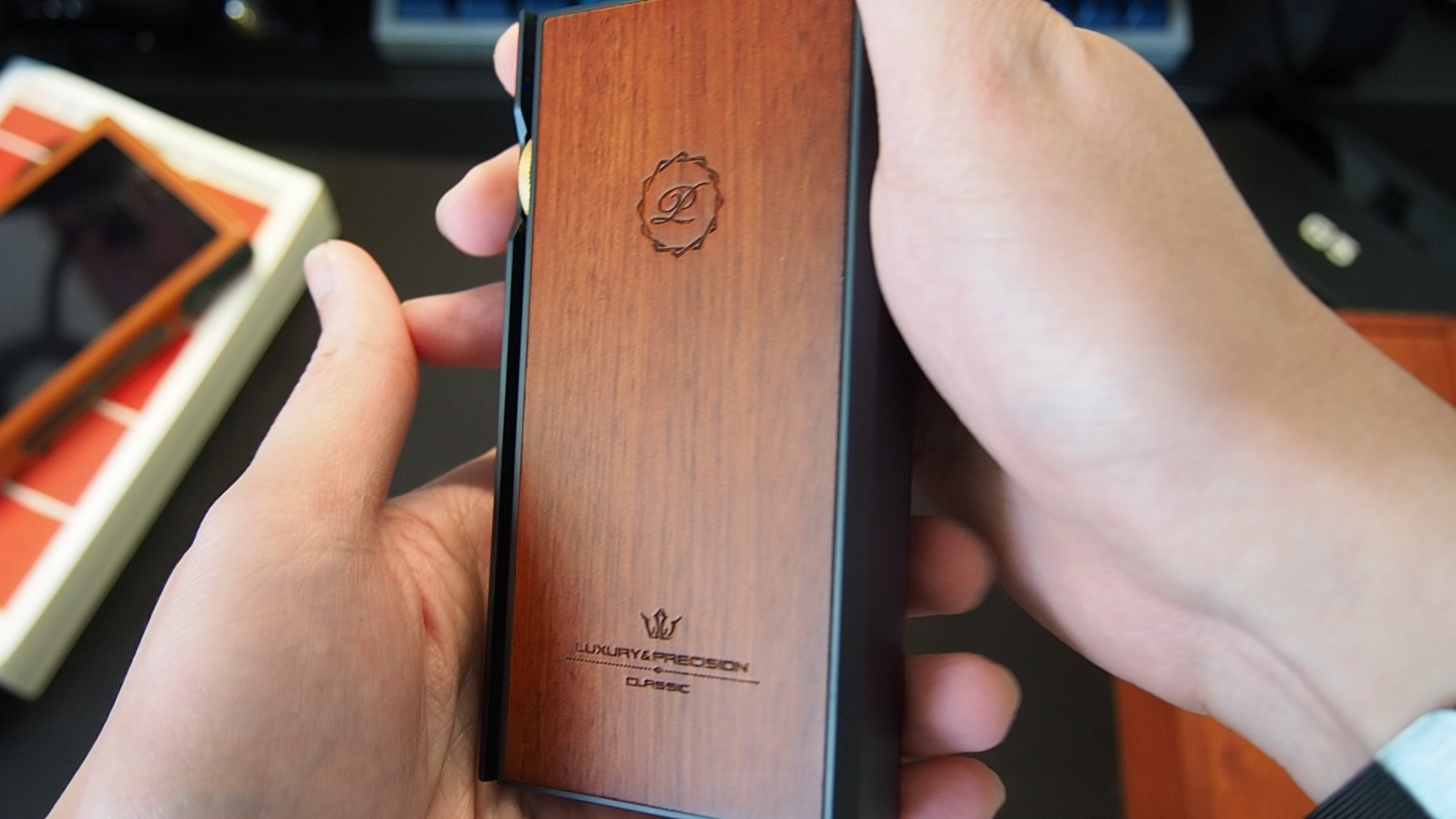
Joke aside, the DAP looks and feels like a luxury product rather than an electronic device. This impression might be due to the player’s wooden back plate and somewhat dated but classy design.

P6 Pro is surprisingly thick, yet small and light, compared to other medium-sized DAPs like Shanling M6 Ultra and HiBy RS6. Thanks to the size and weight, P6 Pro feels good in hands and is easy to control.
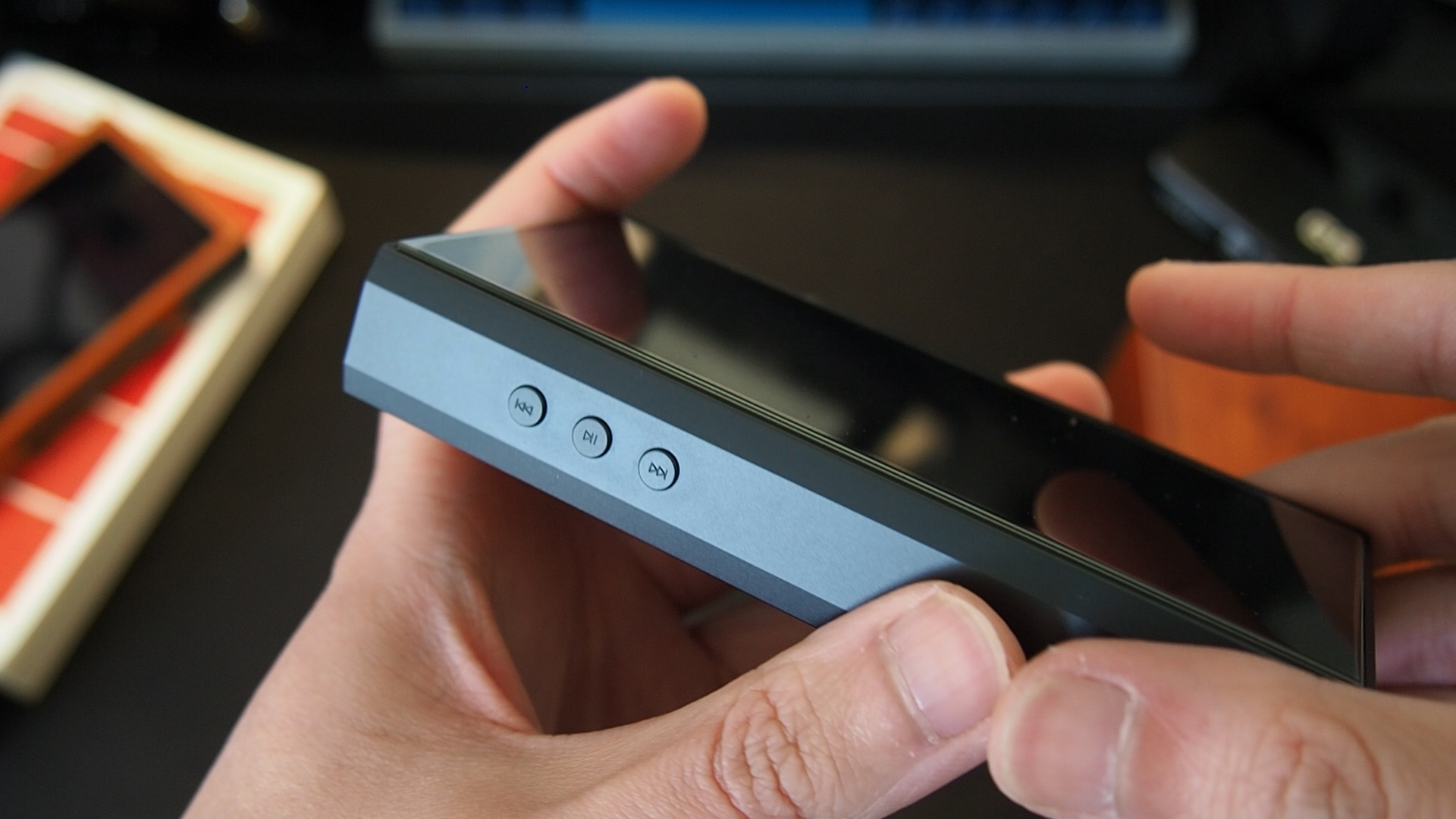
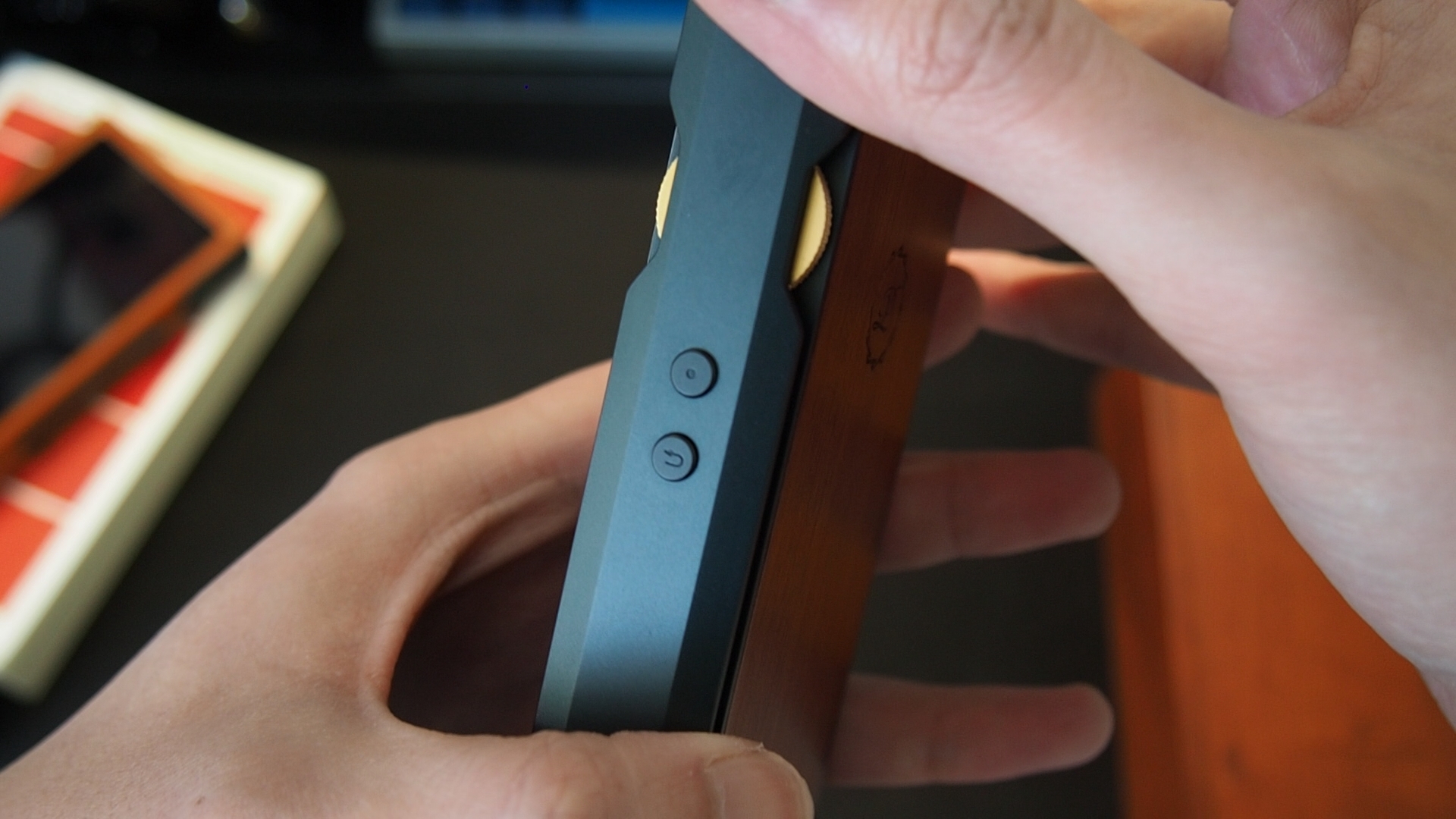
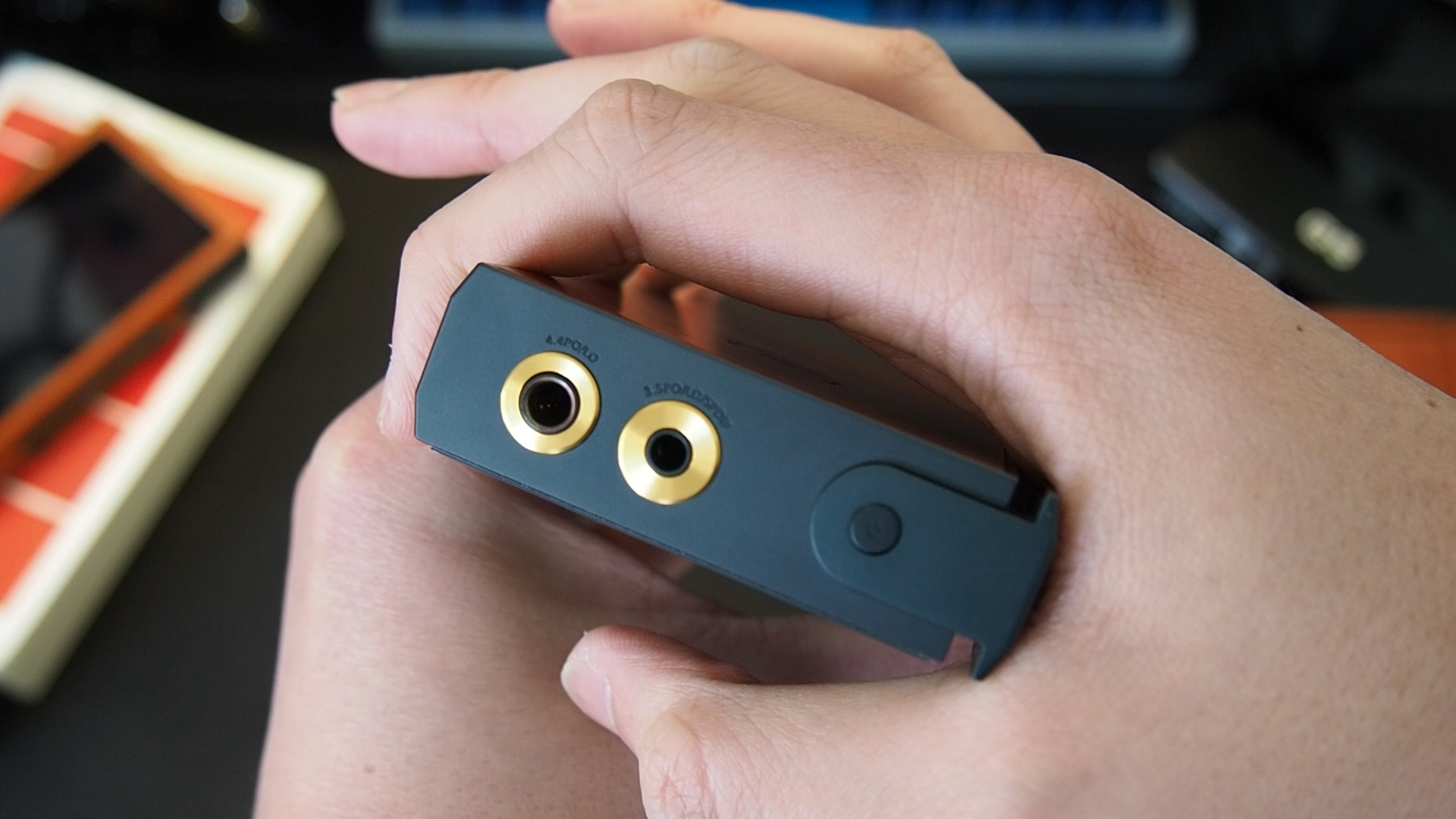
Like most modern DAPs, P6 Pro has physical playback control buttons and a touchscreen. Unlike other DAPs, you can also interact with the menus of P6 Pro using the volume wheels and two buttons on the player’s right-hand side.
The “somewhat dated” impression applies to the software of P6 Pro even more aptly than its hardware. The graphical user interface of P6 Pro mostly devoids of images besides the animated boot screen and the music player page. The lack of artwork in the album list is the most shocking omission.
That said, I enjoy the minimalistic software of P6 Pro because it allows me to turn on the device and start playing music within only a few seconds.
After booting the device, you are greeted with a grey menu with 8 options for resume playing music, browsing and updating your music library, and adjusting settings. The available settings are pretty basic. You wouldn’t find extensive parametric EQ or be able to customise the operation of the DAC beyond changing the digital filters. P6 Pro defaults to Non-Over-Sampling mode, which I prefer when using a device with R2R DAC.
You can use P6 Pro in a few ways:
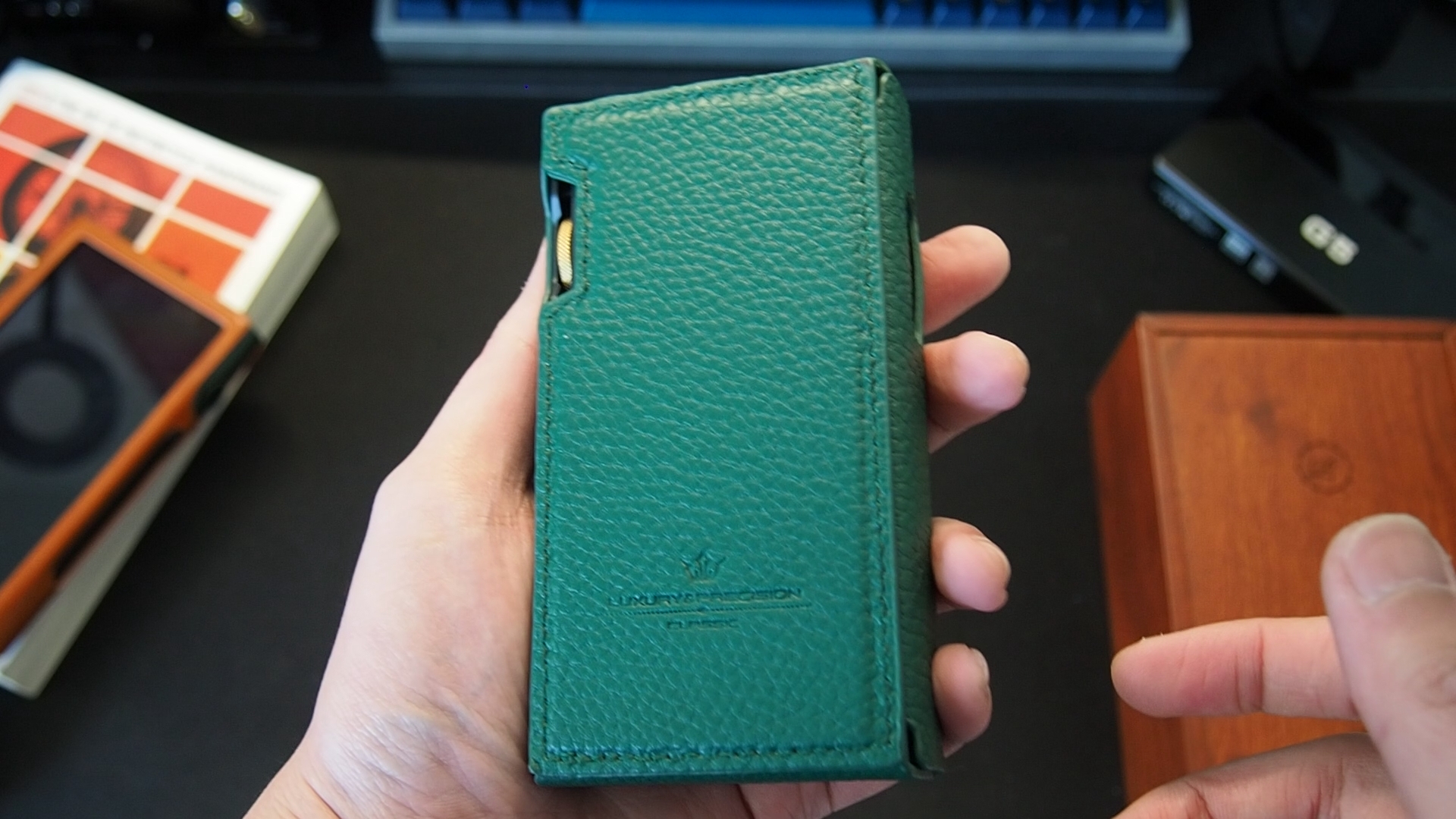
Before we move on, I do have a few bones to pick with P6 Pro about the software:
Perceived Tonality: When I heard that P6 Pro has a discrete R2R DAC, I immediately expected a warm and dark sound signature that can be pleasing or “musical” with some IEMs, and not much so with others. The tonality of P6 Pro confirms and challenges that expectation at the same time.
Let’s start with the treble. P6 Pro does reduce energy in this region to soften the attacks of musical notes, creating that R2R “smooth” tonality. The softening of treble is immediately noticeable when switching over from source with delta-sigma DAC, even a smooth and warm one like Shanling M6 Ultra. At the same time, P6 Pro is not as smooth and dark as HiBy RS6, another R2R DAP.
The midrange tonality of the P6 Pro does not have the exaggerated warmth that I expect from an R2R device. All midrange instruments and vocals sound similar to the venerable Apple dongle: natural with a slight hint of warmth in the lower end. P6 Pro does not make the midrange thin to improve the perceived clarity like some DAC+amp dongles. At the same time, it does not have the exaggerated warmth and weight in the fundamental frequencies of vocals and instruments like HiBy RS6 either. I was also quite surprised to realise that the lower midrange of the P6 Pro is less “bulky” than my FiiO K7 with AKM AK4493 DAC chips.
To me, the bass of the P6 Pro is the brightest star of its performance. The best word to describe the bass response of the P6 Pro is “tight.” Bass notes have tack-sharp attacks with a clear jump in loudness. At the same time, P6 Pro does not sacrifice the decay and reverberation of bass notes in pursuing that snappy bass response. As a result, even IEMs with dull bass responses, like the Andromeda 2020, receive a boost in rhythm and dynamics.
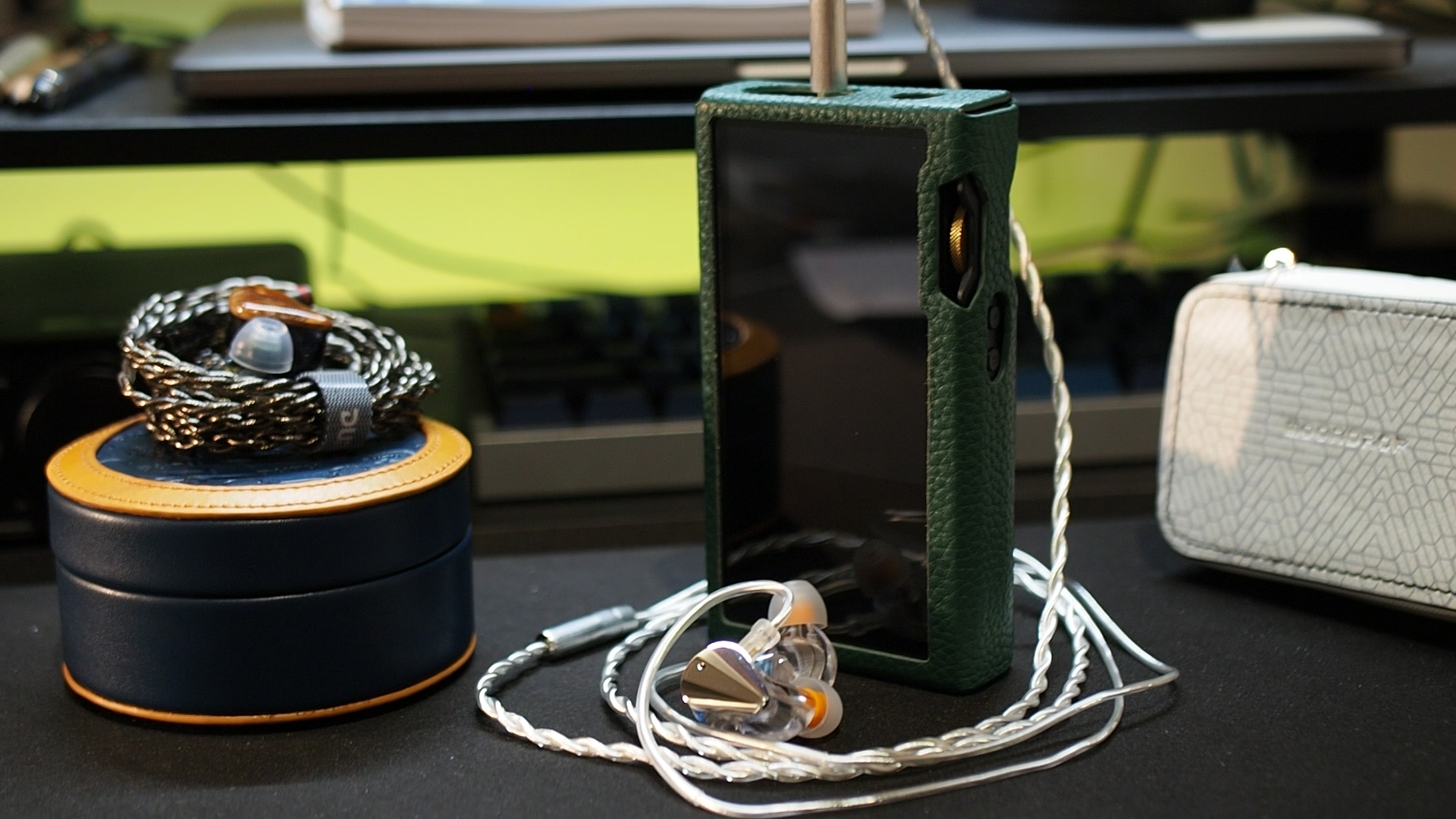
Perceived Technical Performance: P6 Pro is very adept at revealing micro details of recordings in a natural way. This top-notch resolution is not for bragging (“I can hear chair shifting, but you can’t, I’m superior”). It is also not about hearing more instruments or vocals but about the nuances, textures, and details within them. The nuances and micro details create an incredible sense of realism, especially with classical recordings, making you feel like you are right there where the microphones are placed.
Another advantage of the P6 Pro is the soundstage depth. This DAP pushes the whole soundstage out and away from me more than any other source in my collection. It also has the uncanny ability to make the background layers of the soundstage sound distant, sometimes creating “holographic” stereo images even with IEMs generally not good with staging. For instance, when the choir comes in at 1:25 in the One-Winged Angel performance by the Danish National Symphony Orchestra, only P6 Pro can convincingly push the choir far to the background, outside my head stage. My other sources either put the choir on the same layer as the rest of the orchestra (worst) or slightly behind the orchestra without leaving the head stage.
Perceived dynamic is another advantage of P6 Pro. As mentioned in the bass response, P6 Pro is exceptional at conveying rapid jumps in loudness at the attacks of musical notes. It also does an excellent job reproducing ebbs and flows in the dynamic levels throughout a recording.

Average IEMs: Driving average IEMs like Dunu SA6II and Blessing 2 is the first test for any source reaching my review desk. These IEMs fall within the amplification sweet spot of the Apple dongle (around 42ohms, 104dB/mW) and tend not to improve significantly unless a source is exceptional. Both Blessing 2 and SA6II received a significant boost in soundstage imaging and bass quality from P6 Pro. In the test track Battle Bar, I can hear snappier bass attacks and stronger reverberation of the bass across the soundstage. The sense of layering and depth is also heightened, evidenced in the clear contrast between closer and further sounds when instruments jump around the soundstage. Most of the issues I have with the technical performance of Blessing 2 when paired with an Apple dongle are fixed by P6 Pro.
Compared to Shanling M6 Ultra, I hear a more expansive soundstage and significantly more snappy and impactful bass response with P6 Pro. The L&P DAP also provides more soundstage depth and clarity compared to the Topping G5. Only the combination of M6 Ultra’s DAC and G5’s amplifier can get close to the performance of P6 Pro. Yet, a gap in detail retrieval still exists between the M6U+G5 combo and P6 Pro. In conclusion, the sound quality of P6 Pro, when paired with average IEMs, is outstanding (5/5).
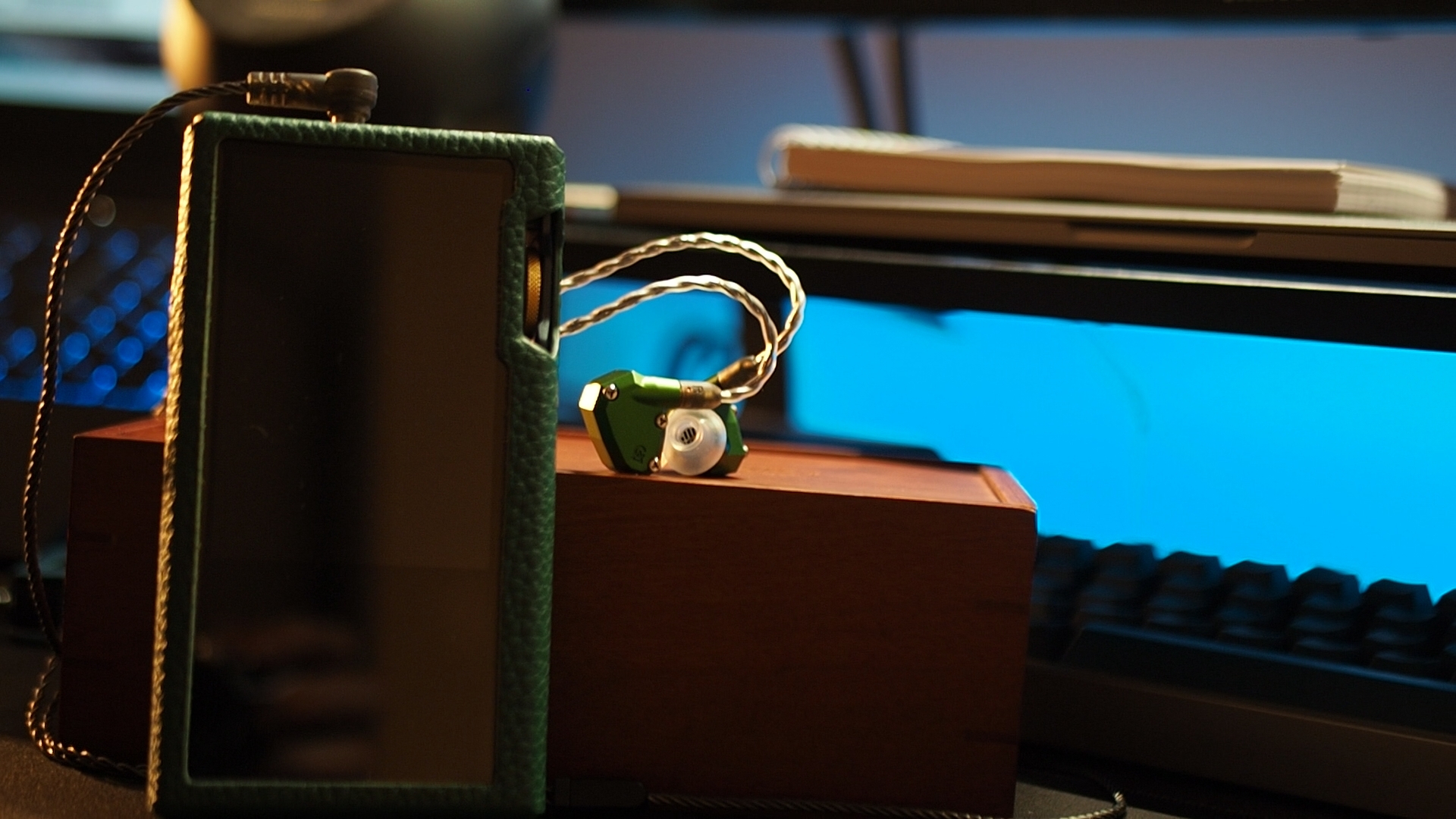
Low-impedance, high-sensitivity IEMs: The next test is with the hypersensitive and notoriously picky Campfire Audio Andromeda 2020. P6 Pro does an outstanding job again. I did not hear intrusive noises or hisses, even in quiet musical phrases. The punchy and dynamic presentation of the P6 Pro perfectly compensates for the lacking dynamic of Andromeda 2020. The soundstage imaging of Andromeda is also maximised with P6 Pro. The Andromeda sounds better with P6 Pro than any other combination, including the M6U+G5 combo. Outstanding (5/5)
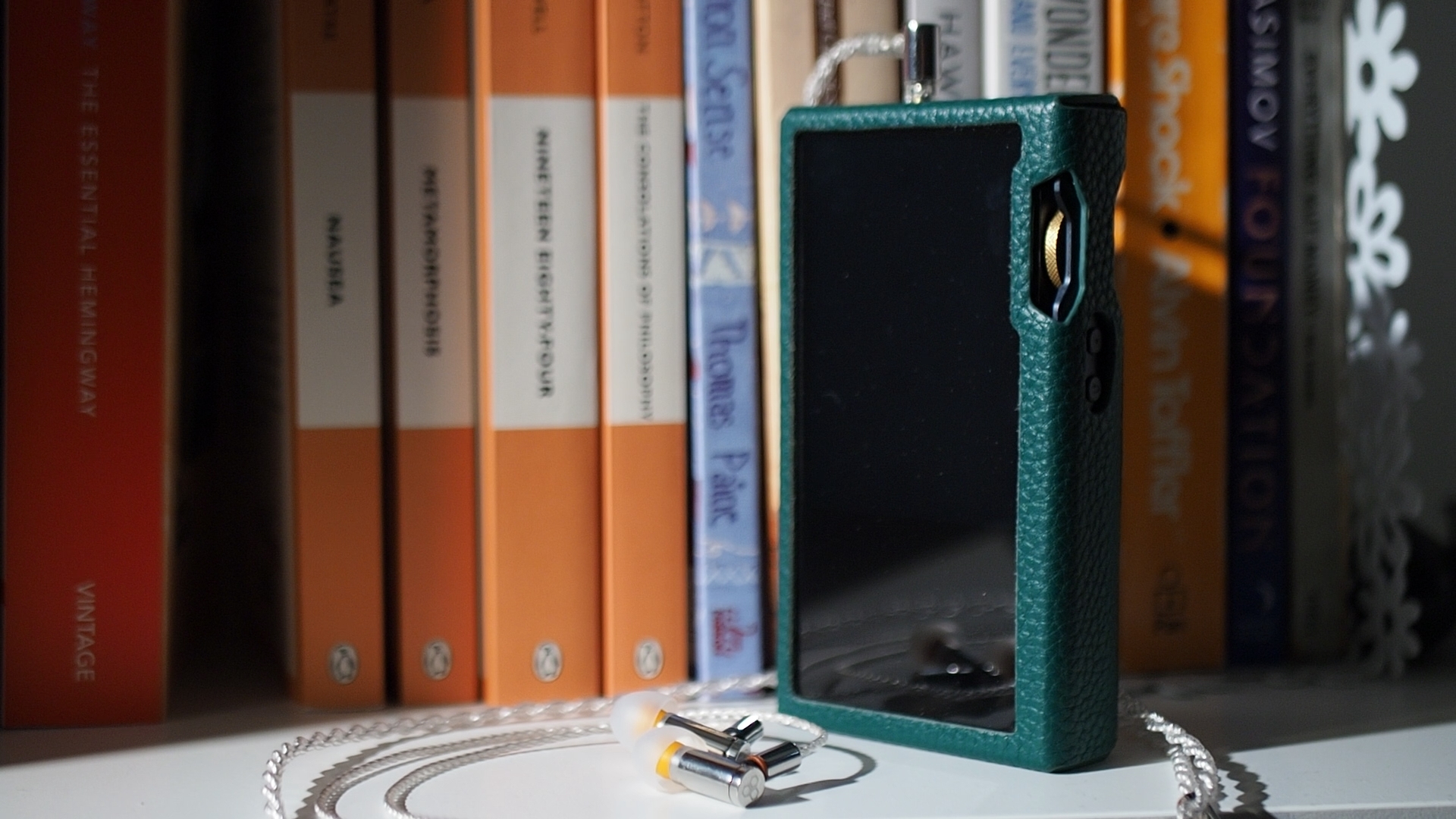
Low-impedance, low-sensitivity IEM: The next test is with the Final Audio E5000. Despite the petite appearance, Final Audio E5000 is one hell of an IEM to drive due to low impedance, low sensitivity, and significant bass boost. I needed to switch to high-gain mode and crank the volume on P6 Pro to reach a usable loudness. The L&P DAP, again, presents an outstanding performance, making E5000 sound spacious, clear, and snappy. The advantage of the amplifier in P6 Pro compared to M6U is clearly felt in this test. Outstanding (5/5)
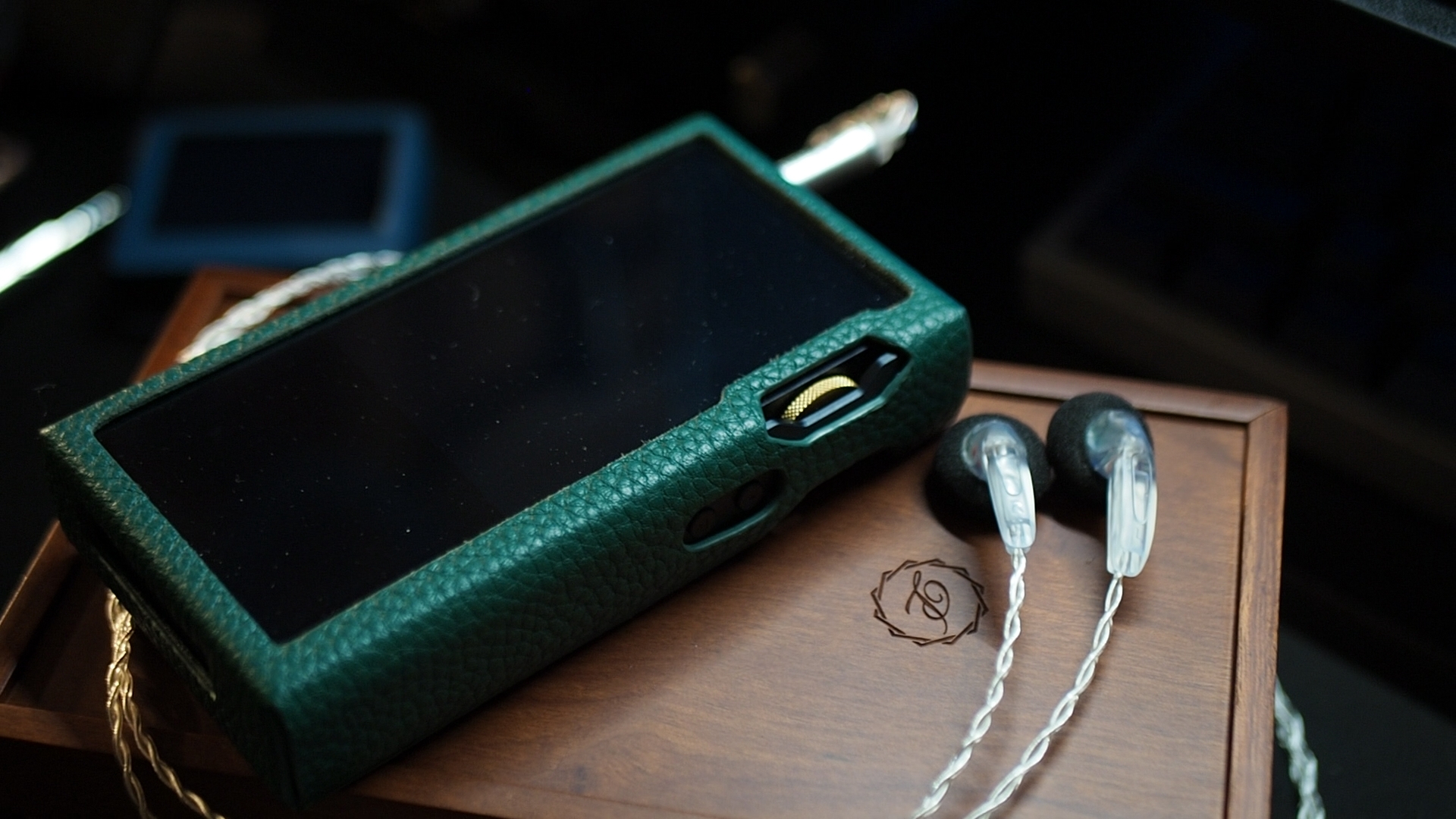
High-impedance transducers (5/5) The final test is with Serratus,a pair of 300ohm flathead earbuds made by a fellow head-fi reviewer known as tgx78. P6 Pro brings noticeable and appreciable improvement compared to M6U and G5 in depth, layering, and detail retrieval. However, the most significant difference comes from the smoother treble response. The reduction in the “edginess” of the sound is unmissable. Again, outstanding (5/5)
My current hypothesis is that P6 Pro’s “magic sauce” stems from a combination of a very capable amplification and the refined R2R DAC. To get somewhat close to P6 Pro’s sound, I need to pair the quad-AKM DAC of Shanling M6 Ultra with the clean and powerful NFCA amplification in Topping G5. I imagine an R2R DAP like HiBy RS2 combined with a portable amplifier like Topping NX7 can get closer to P6 Pro. Interestingly, I also have good experience pairing the Apple dongle with G5.
I still have a few questions. For instance, what exactly made the amplification of P6 Pro “powerful”? Or, to put it another way, what makes the M6U struggle to push the E5000 to the same level as P6 Pro? The max output power does not seem to be the answer, given that none of the IEMs demand near the max power of any of these amplifiers, even when we account for 120dB transient peaks.
Should you get a P6 Pro? That, I cannot say. Only you can decide whether that top-of-the-line sound quality is worth the ultra-high price tag and limited software.
Pros:
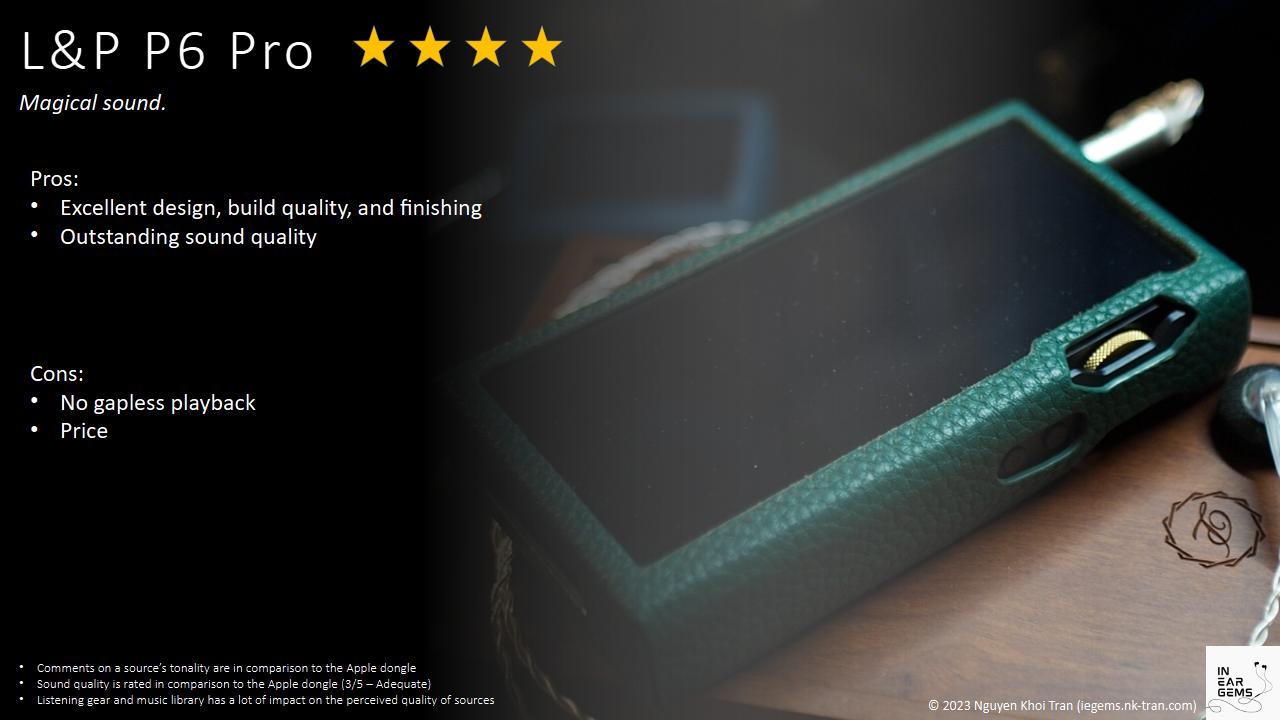
Updated: May 6, 2023
If you want to listen instead of reading, please find the video review on YouTube below. Otherwise, read on, friends.
Preambles:
- In this review, I use the term “source” to denote a DAC+amp combo for brevity and convenience.
- Sources do not make sounds. Therefore, when I say sources “sound” a certain way, I talk about the change they make to my IEMs and earphones.
- I want my music to be crisp, clear, well-separated and form a 3D soundstage around my head. Sources that intensify those characteristics of my IEMs are considered “better”.
- This review is possible thanks to the Australian Head-Fi Tour arranged by @Damz87. The sample of P6 Pro will be sent to the next reviewer in the tour after this review.
Specs:
- Operating system: own system (not Android)
- Decoding chip: Discrete R-2R DAC equivalent to 16 PCM1704K chips
- Screen: 3.5-inch touch-sensitive IPS screen (480 × 320)
- Built-in storage capacity: 64GB
- Expansion interface: microSD, up to TB
- Wireless network: Wi-Fi 2.4GHz, Bluetooth 5.0 (LDAC, aptX HD, aptX, AAC, SBC)
- Support music formats: APE, AAC, ALAC, FLAC, WAV, MP3, WMA, DFF, DSF, AIFF, SACD-ISO et
- Highest sampling rate: PCM 24bit / 384kHz, DSD256
- Terminal: 4.4mm balance (PO / LO), 3.5mm unbalanced (PO / LO / SPDIF), USB-C (USB DAC)
- Output power: 5.2Vrms / 3.1Vrms ( Balanced), 3.245Vrms/1.55Vrms (unbalanced)
- Continuous playback time: about 15 hours (4,000mAh)
Non-sound Aspects



My first impression when unboxing the unit was luxury (and precision). The DAP comes in a heavy wooden box that feels great to the touch, looks luxurious and, thanks to the magnets, closes precisely with a satisfying snap. After removing a protective foam panel, you will find the luxurious DAP sitting on a layer of precisely cut foam. (Alright, alright, I’ll stop).


Joke aside, the DAP looks and feels like a luxury product rather than an electronic device. This impression might be due to the player’s wooden back plate and somewhat dated but classy design.

P6 Pro is surprisingly thick, yet small and light, compared to other medium-sized DAPs like Shanling M6 Ultra and HiBy RS6. Thanks to the size and weight, P6 Pro feels good in hands and is easy to control.



Like most modern DAPs, P6 Pro has physical playback control buttons and a touchscreen. Unlike other DAPs, you can also interact with the menus of P6 Pro using the volume wheels and two buttons on the player’s right-hand side.
The “somewhat dated” impression applies to the software of P6 Pro even more aptly than its hardware. The graphical user interface of P6 Pro mostly devoids of images besides the animated boot screen and the music player page. The lack of artwork in the album list is the most shocking omission.
That said, I enjoy the minimalistic software of P6 Pro because it allows me to turn on the device and start playing music within only a few seconds.
After booting the device, you are greeted with a grey menu with 8 options for resume playing music, browsing and updating your music library, and adjusting settings. The available settings are pretty basic. You wouldn’t find extensive parametric EQ or be able to customise the operation of the DAC beyond changing the digital filters. P6 Pro defaults to Non-Over-Sampling mode, which I prefer when using a device with R2R DAC.
You can use P6 Pro in a few ways:
- A standalone DAP. You just need to supply your favourite IEM and enjoy.
- A USB DAC+amp for your laptop or desktop computer. To enable this feature, go to the “Advanced” menu and switch the USB connection mode to USB Audio. You might also want to change the USB Audio Delay setting to “Short Delay”.
- A Bluetooth DAC+amp. To enable Bluetooth mode, go to the “BlueTooth Settings” menu and toggle the BlueTooth Switch to “On.” Your phone or tablet should be able to discover and connect to P6 Pro via Bluetooth afterwards. I found the sound quality nearly as good as wired, and the delay is minimal, even when using the AAC codec.
- A digital transport. You must first remove your IEMs from the headphone jacks. Afterwards, switch the output from the headphone out to line out in the “Audio output settings.” Subsequently, you can use an aux cable to connect the output jacks of P6 Pro to the suitable input of an amplifier.

Before we move on, I do have a few bones to pick with P6 Pro about the software:
- This device does not work with multi-CD albums well unless the files are named in a sortable way, such as “1-1-track” for CD1 and “2-1-track” for CD2. Meanwhile, FiiO’s music app and HiBy player on my Hidizs AP80 Pro X can correctly recognise and order the tracks.
- I cannot find any option to sort tracks by name when I browse and play music from folders. So, for example, when I try to listen to CD1 of an album, all tracks in the CD1 are played randomly rather than following the numerical order in the file names.
- Speaking of classical, the most significant issue of P6 Pro is that this player does NOT have gapless playback. There is always a 3-second gap with an audible pop between tracks. This flaw is a dealbreaker if you listen to classical recordings such as Goldberg Variations.
Sound Performance
Overview: Let’s cut to the chase. P6 Pro sounds very very good. What surprises me is how P6 Pro elevates the technical performance of my IEMs (staging, clarity, detail retrieval, dynamic) to a new level without making them bright or edgy. The difference was so pronounced that it forced me to reconsider my entire setup.Perceived Tonality: When I heard that P6 Pro has a discrete R2R DAC, I immediately expected a warm and dark sound signature that can be pleasing or “musical” with some IEMs, and not much so with others. The tonality of P6 Pro confirms and challenges that expectation at the same time.
Let’s start with the treble. P6 Pro does reduce energy in this region to soften the attacks of musical notes, creating that R2R “smooth” tonality. The softening of treble is immediately noticeable when switching over from source with delta-sigma DAC, even a smooth and warm one like Shanling M6 Ultra. At the same time, P6 Pro is not as smooth and dark as HiBy RS6, another R2R DAP.
The midrange tonality of the P6 Pro does not have the exaggerated warmth that I expect from an R2R device. All midrange instruments and vocals sound similar to the venerable Apple dongle: natural with a slight hint of warmth in the lower end. P6 Pro does not make the midrange thin to improve the perceived clarity like some DAC+amp dongles. At the same time, it does not have the exaggerated warmth and weight in the fundamental frequencies of vocals and instruments like HiBy RS6 either. I was also quite surprised to realise that the lower midrange of the P6 Pro is less “bulky” than my FiiO K7 with AKM AK4493 DAC chips.
To me, the bass of the P6 Pro is the brightest star of its performance. The best word to describe the bass response of the P6 Pro is “tight.” Bass notes have tack-sharp attacks with a clear jump in loudness. At the same time, P6 Pro does not sacrifice the decay and reverberation of bass notes in pursuing that snappy bass response. As a result, even IEMs with dull bass responses, like the Andromeda 2020, receive a boost in rhythm and dynamics.

Perceived Technical Performance: P6 Pro is very adept at revealing micro details of recordings in a natural way. This top-notch resolution is not for bragging (“I can hear chair shifting, but you can’t, I’m superior”). It is also not about hearing more instruments or vocals but about the nuances, textures, and details within them. The nuances and micro details create an incredible sense of realism, especially with classical recordings, making you feel like you are right there where the microphones are placed.
Another advantage of the P6 Pro is the soundstage depth. This DAP pushes the whole soundstage out and away from me more than any other source in my collection. It also has the uncanny ability to make the background layers of the soundstage sound distant, sometimes creating “holographic” stereo images even with IEMs generally not good with staging. For instance, when the choir comes in at 1:25 in the One-Winged Angel performance by the Danish National Symphony Orchestra, only P6 Pro can convincingly push the choir far to the background, outside my head stage. My other sources either put the choir on the same layer as the rest of the orchestra (worst) or slightly behind the orchestra without leaving the head stage.
Perceived dynamic is another advantage of P6 Pro. As mentioned in the bass response, P6 Pro is exceptional at conveying rapid jumps in loudness at the attacks of musical notes. It also does an excellent job reproducing ebbs and flows in the dynamic levels throughout a recording.
Comparisons and Ratings
Gears for A/B tests:- Shanling M6 Ultra + Topping G5
- FiiO K7
- Apple USB-C to 3.5mm dongle
- Moondrop Blessing 2 (22ohm, 117dB/Vrms)
- Dunu SA6 MkII (24ohm, 114dB/Vrms)
- Campfire Audio Andromeda 2020 (8.7ohm, 122.5dB/mW)
- Final Audio E5000 (14ohm, 93dB/mW)
- TGXear Serratus (300ohm)

Average IEMs: Driving average IEMs like Dunu SA6II and Blessing 2 is the first test for any source reaching my review desk. These IEMs fall within the amplification sweet spot of the Apple dongle (around 42ohms, 104dB/mW) and tend not to improve significantly unless a source is exceptional. Both Blessing 2 and SA6II received a significant boost in soundstage imaging and bass quality from P6 Pro. In the test track Battle Bar, I can hear snappier bass attacks and stronger reverberation of the bass across the soundstage. The sense of layering and depth is also heightened, evidenced in the clear contrast between closer and further sounds when instruments jump around the soundstage. Most of the issues I have with the technical performance of Blessing 2 when paired with an Apple dongle are fixed by P6 Pro.
Compared to Shanling M6 Ultra, I hear a more expansive soundstage and significantly more snappy and impactful bass response with P6 Pro. The L&P DAP also provides more soundstage depth and clarity compared to the Topping G5. Only the combination of M6 Ultra’s DAC and G5’s amplifier can get close to the performance of P6 Pro. Yet, a gap in detail retrieval still exists between the M6U+G5 combo and P6 Pro. In conclusion, the sound quality of P6 Pro, when paired with average IEMs, is outstanding (5/5).

Low-impedance, high-sensitivity IEMs: The next test is with the hypersensitive and notoriously picky Campfire Audio Andromeda 2020. P6 Pro does an outstanding job again. I did not hear intrusive noises or hisses, even in quiet musical phrases. The punchy and dynamic presentation of the P6 Pro perfectly compensates for the lacking dynamic of Andromeda 2020. The soundstage imaging of Andromeda is also maximised with P6 Pro. The Andromeda sounds better with P6 Pro than any other combination, including the M6U+G5 combo. Outstanding (5/5)

Low-impedance, low-sensitivity IEM: The next test is with the Final Audio E5000. Despite the petite appearance, Final Audio E5000 is one hell of an IEM to drive due to low impedance, low sensitivity, and significant bass boost. I needed to switch to high-gain mode and crank the volume on P6 Pro to reach a usable loudness. The L&P DAP, again, presents an outstanding performance, making E5000 sound spacious, clear, and snappy. The advantage of the amplifier in P6 Pro compared to M6U is clearly felt in this test. Outstanding (5/5)

High-impedance transducers (5/5) The final test is with Serratus,a pair of 300ohm flathead earbuds made by a fellow head-fi reviewer known as tgx78. P6 Pro brings noticeable and appreciable improvement compared to M6U and G5 in depth, layering, and detail retrieval. However, the most significant difference comes from the smoother treble response. The reduction in the “edginess” of the sound is unmissable. Again, outstanding (5/5)
Some discussions
Before we move on, let me put on the record that I believe any improvement in subjective listening experience has engineering causes rather than a mystical “magic touch” of the manufacturers. If measurements do not reflect subjective listening experiences, we might be using the wrong metrics to quantify that experience. At the same time, not knowing how such an experience can be created does not mean it is a “product of imagination.”My current hypothesis is that P6 Pro’s “magic sauce” stems from a combination of a very capable amplification and the refined R2R DAC. To get somewhat close to P6 Pro’s sound, I need to pair the quad-AKM DAC of Shanling M6 Ultra with the clean and powerful NFCA amplification in Topping G5. I imagine an R2R DAP like HiBy RS2 combined with a portable amplifier like Topping NX7 can get closer to P6 Pro. Interestingly, I also have good experience pairing the Apple dongle with G5.
I still have a few questions. For instance, what exactly made the amplification of P6 Pro “powerful”? Or, to put it another way, what makes the M6U struggle to push the E5000 to the same level as P6 Pro? The max output power does not seem to be the answer, given that none of the IEMs demand near the max power of any of these amplifiers, even when we account for 120dB transient peaks.
Conclusion
Judging by sound quality alone, P6 Pro is, without a doubt, a top-of-the-line product. A janky combination of a DAP and a portable amplifier is necessary to get close to the sound quality that P6 Pro can achieve in an elegant and classy package. However, the software is subpar, lacking basic features like gapless playback. And then, the elephant in the room: the $3899 price tag.Should you get a P6 Pro? That, I cannot say. Only you can decide whether that top-of-the-line sound quality is worth the ultra-high price tag and limited software.
Pros:
- Excellent design, build quality, and finishing
- Outstanding sound quality
- No gapless playback
- Price

Updated: May 6, 2023
MoguGG
Its casing is so beautiful, how much does it cost?
o0genesis0o
@MoguGG $3899 Sorry, didn't read carefully  I don't know the pricing of the case. MusicTeck does not sell the case separately.
I don't know the pricing of the case. MusicTeck does not sell the case separately.
 I don't know the pricing of the case. MusicTeck does not sell the case separately.
I don't know the pricing of the case. MusicTeck does not sell the case separately.
MoguGG
lol, thanks 

